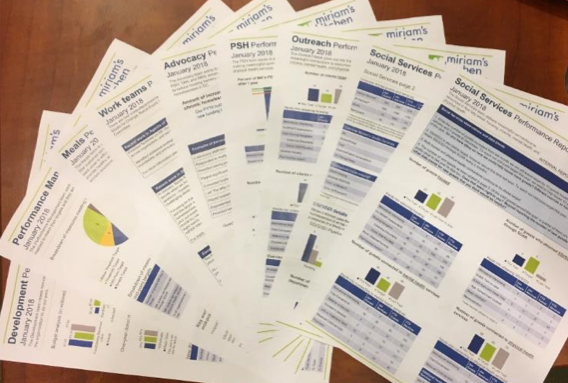
Hi! I’m Andrea Scallon, the ME&L Officer at Miriam’s Kitchen – working to end chronic homelessness in DC.
In 2015, the Performance Management (PM) department was created with a focus of helping programs determine goals, reporting on progress, and facilitate learning. While there was excitement about how data could help fuel the organization’s mission, there was some hesitancy. How do you help staff view PM as valuable partners in achieving the mission instead of officers policing their work?
Challenge 1: Overcoming the “police” image
Our front-line staff are helping guests experiencing homelessness overcome crises like getting medical care, providing a healthy but delicious meal, and helping them move into a safe, permanent home. Acknowledging the critical work and true impact program staff have on people’s live, goes a long way. Clearly communicate your role is to help goalsetting and reporting truth through data so they can refine their work processes.
Our PM team invests in building strong relationships with all staff. One way we do this is by rolling up our sleeves to help. Once a month we volunteer four hours in another department on whatever they ask. Not only is this helping them but we get insight into programs and understand the demands on others when we ask for data, time, and feedback.
Lesson Learned 1: Create true partnerships and build strong relationships with all staff. Communicate everyone has a piece of the puzzle that is your mission.
Challenge 2: Creating one report for staff to use and communicate progress externally
Some people might be able to look at numbers in a spreadsheet and see trends but creating a visually appealing report will speak to more people. Balancing the needs of program staff and communicating to external stakeholders will be hard. However, having one report to show true progress of the whole organization will be impactful. It took us until 2017 before we had that balance.
Our first report was an easy to digest infographic but it lacked context for external stakeholders. Without the context, the truth of the numbers could be missed. Our 2016 report went in detail on the context with a scorecard for our data. This was great to communicate to our stakeholders; however, we thought we could provide true insights for staff. Our 2017 reports provide insights, context, and digestible charts. Thanks to our grant from Measure4Change, our Quarter 2 report received praise from staff. This format has continued into 2018 and with streamlined monthly internal reports for each program.

Lesson Learned 2: Present staff with a visually appealing report with insights and context to show true impact. Just start, once you have a report it is easy to get feedback.
Overall, for the non-profits out there thinking about deepening your evaluation practices, I would say Just start! Learn from the process, outcome, and your coworkers.
Do you have questions, concerns, kudos, or content to extend this aea365 contribution? Please add them in the comments section for this post on the aea365 webpage so that we may enrich our community of practice. Would you like to submit an aea365 Tip? Please send a note of interest to aea365@eval.org. aea365 is sponsored by the American Evaluation Association and provides a Tip-a-Day by and for evaluators.
